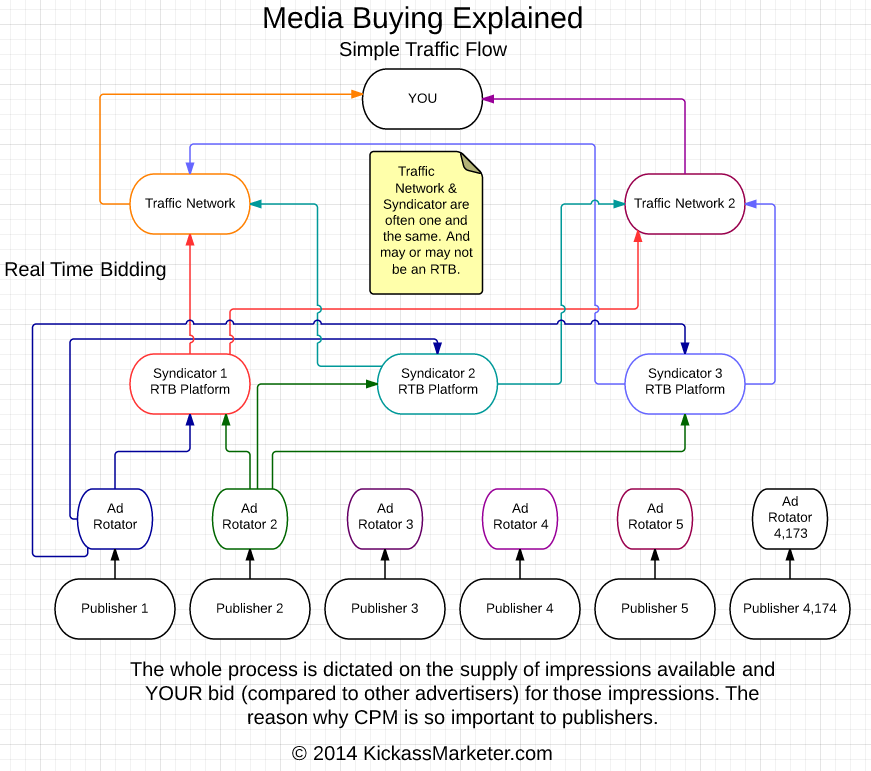Preface: To dispel some of the myths and possibly lift some of the cloud of mystery over Media Buying, I present this training to the Internet Marketing World as a gift to young, small, big, and tall. I hope it is a blessing to you all. Totally in the flow there…not even trying to rhyme…maybe I am missing my calling. 🙂
Introduction to Media Buying
The words Media Buying are often referenced in the Online Marketing space, and depending on who is the one using them, it can mean slightly different things.
Before Mobile Internet became as dominant as it is now, Media Buying typically referred to a large Brand Advertiser buying ad placements on a large website or network of sites. Think Coke buying traffic from MSN.com.
The relationship between the Advertiser (Coke) and the Publisher (MSN.com) was typically one where the Publisher had an in-house team of placement specialists (Ad Reps) and the Advertiser had an in-house team of Media Buyers.
Direct Media Buys
The Publisher would send the Advertiser an Insertion Order (IO) that would detail the placement (where the ads would be shown, for how long, at what cost (per CPM or 1,000 impressions), and the total ad budget. There would also be an out-clause allowing the Advertiser to pause the campaign with 24-48 hours. The main concern of both sides for the most part is to get a consistent flow of traffic at the price desired for the whole period of time. Example, Coke wants their ads shown on the front page of MSN.com for 90 days at $2.00 per 1,000 impressions and not to exceed $6,000,000 per month (or $200,000 per day). The IO would be signed for a 90 day window, but could be for an entire year.
The Brand Advertiser typically wants a consistent flow of traffic so 200,000 impressions per day for the whole year. Because they are building and reinforcing the consumers affinity for their brand and seek to build good will and loyalty to that brand. They aren’t interested in calculating a return on investment (ROI), how could they even if they wanted to.
Direct Media buys in this fashion are still the norm for Brand Advertisers and I am personally still active in this capacity with some VERY well known Publisher Brands.
Side-note: Most big publishers do not understand or care to know ROI for you. Watch the video for a detailed discussion on how the publisher reps think when selling you direct buy media.
Self-Serve Media Buying
With the evolution of the Internet and advertising platforms came the option of self-serve platforms where the advertiser can now setup their campaigns without the managed help of the publisher. This self-serve media buying is typically done by a third-party who has negotiated an agreement with not one, but many puiblishers. It is typically for the publisher’s (MSN.com) excess inventory, the inventory of impressions that they have not successfully sold to the Brand Advertisers directly.
Their are many of these self-serve media buying platforms available, Sitescout.com is one of many that I’ve used myself, but their are literally hundreds available today. You can find them here –> Self-Serve Media Buying Platforms
They come in all shapes and sizes but, typically they specialize in prime publisher traffic or sub-prime, and some specialize in only desktop, some in mobile, and some have both mobile & desktop media that you can buy.
Background on how the traffic flows for a Self-Serve Media Buy Campaign
On any given Self-Serve Media Buy Platform there is a complex network of moving pieces and entities involved between your campaign and the end user who generated the impression. I will detail it in depth in the video below, but will detail some of the basics here:
You setup a campaign targeting a certain geography (USA for example) and are willing to pay $2.00 per 1,000 impressions, which is fairly cheap. I’ve heard of Brand Advertisers paying in the $5-$10 per 1,000 and higher at times. You load your campaign with banners specific to your campaign and depending on the sophistication of the platform (meaning they might have more targeting options) you are done. You set the start time and end time and total budget. You may be able to set a daily budget as well depending on the platform.
Then the magic happens (which I will detail in the video below), but for the most part your ad will be displayed across the whole network of websites that the platform has access to. This is usually thousands or tens of thousands (maybe 100’s of thousands) of websites and mobile apps.
Watch this video for more detail on the challenges of optimizing mobile campaigns in the following:
https://kickassmarketer.com/mobile-traffic-the-blessing-the-curse-part-1/
https://kickassmarketer.com/mobile-traffic-the-blessing-the-curse-part-2/
and the video here:
https://kickassmarketer.com/contest-behind-the-scenes-private-tour-of-mobile-advertiser-portal-tour/
Key points covered in this video are:
- How the publisher distributes the impressions from their property (website of application)
- How the syndicator acquires traffic from the publisher
- The Traffic Network and syndicator relationship
- How Real Time Bidding becomes a factor in whether you receive traffic or not
- The Supply & Demand relationship and how that dictates where Media Buy Traffic is distributed
- I also explain Run of Network traffic and how to use it
- Tips on where to buy the cheapest Self-Serve Media Buy Traffic known to mankind
- I’ll explain why Media Buy Traffic shift from time to time
Introduction to Media Buying Video
I will cover in more detail, the relationship of your individual campaign settings and how they will determine whether you receive a ton of traffic, some traffic, or no traffic in my next post and video called Mobile Media Buying Explained – Part 2
I hope this was helpful. Please let me know if you have any questions or comments by commenting below.


1 Comment
Dan Wisdom
September 5, 2014 at 5:22 am[…] http://kickassmarketer.com/mobile-media-buying-explained-part-1/ […]